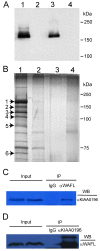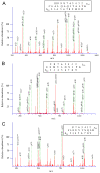The ulcerative colitis marker protein WAFL interacts with accessory proteins in endocytosis
- PMID: 20376207
- PMCID: PMC2850539
- DOI: 10.7150/ijbs.6.163
The ulcerative colitis marker protein WAFL interacts with accessory proteins in endocytosis
Abstract
Ulcerative colitis (UC) is one of the major forms of inflammatory bowel disease with unknown cause. A molecular marker, WAFL, has recently been found to be up-regulated in the inflamed colonic mucosa of UC patients. Towards understanding biological function of WAFL, we analyzed proteins interacting with WAFL in HEK-293 cells by immunoprecipitation and mass spectrometry. Among four proteins found to specifically interact with WAFL, both KIAA0196 and KIAA1033 bind to alpha-appendage of the adaptor protein complex 2 (AP2), which acts as an interaction hub for accessory proteins in endocytosis mediated by clathrin-coated vesicle (CCV). The specific interaction between WAFL and KIAA0196 was also confirmed in human colorectal carcinoma HCT-116 cells by co-immunoprecipitation with specific antibodies. Meta-analyses of the databases of expressed genes suggest that the three genes are co-expressed in many tissues and cell types, and that their molecular function may be classified in the category of 'membrane traffic protein'. Therefore, these results suggest that WAFL may play an important role in endocytosis and subsequent membrane trafficking by interacting with AP2 through KIAA0196 and KIAA1033.
Keywords: Inflammatory bowel disease; KIAA0196/strumpellin; KIAA1033; Proteomics; WAFL/FKBP15/FKBP133/KIAA0674; Wiskott-Aldrich syndrome protein.
Conflict of interest statement
Conflict of Interest: The authors have declared that no conflict of interest exists.
Figures



Similar articles
-
Identification of a new WASP and FKBP-like (WAFL) protein in inflammatory bowel disease: a potential marker gene for ulcerative colitis.Int J Colorectal Dis. 2008 Oct;23(10):921-30. doi: 10.1007/s00384-008-0527-8. Epub 2008 Jul 25. Int J Colorectal Dis. 2008. PMID: 18654788
-
WAFL, a new protein involved in regulation of early endocytic transport at the intersection of actin and microtubule dynamics.Exp Cell Res. 2009 Apr 1;315(6):1040-52. doi: 10.1016/j.yexcr.2008.12.004. Epub 2008 Dec 16. Exp Cell Res. 2009. PMID: 19121306
-
Evolving nature of the AP2 alpha-appendage hub during clathrin-coated vesicle endocytosis.EMBO J. 2004 Nov 10;23(22):4371-83. doi: 10.1038/sj.emboj.7600445. Epub 2004 Oct 21. EMBO J. 2004. PMID: 15496985 Free PMC article.
-
WASP and WAVE proteins: vital intrinsic regulators of cell motility and their role in cancer (review).Int J Mol Med. 2009 Feb;23(2):141-8. Int J Mol Med. 2009. PMID: 19148537 Review.
-
[Effect of macrophages on ulcerative colitis-associated carcinogenesis].Zhong Nan Da Xue Xue Bao Yi Xue Ban. 2012 Jun;37(6):637-41. doi: 10.3969/j.issn.1672-7347.2012.06.017. Zhong Nan Da Xue Xue Bao Yi Xue Ban. 2012. PMID: 22772418 Review. Chinese.
Cited by
-
Functional diversity and pharmacological profiles of the FKBPs and their complexes with small natural ligands.Cell Mol Life Sci. 2013 Sep;70(18):3243-75. doi: 10.1007/s00018-012-1206-z. Epub 2012 Dec 8. Cell Mol Life Sci. 2013. PMID: 23224428 Free PMC article. Review.
-
Genetic disruption of WASHC4 drives endo-lysosomal dysfunction and cognitive-movement impairments in mice and humans.Elife. 2021 Mar 22;10:e61590. doi: 10.7554/eLife.61590. Elife. 2021. PMID: 33749590 Free PMC article.
-
Loss of strumpellin in the melanocytic lineage impairs the WASH Complex but does not affect coat colour.Pigment Cell Melanoma Res. 2016 Sep;29(5):559-71. doi: 10.1111/pcmr.12506. Pigment Cell Melanoma Res. 2016. PMID: 27390154 Free PMC article.
-
Multiple repeat elements within the FAM21 tail link the WASH actin regulatory complex to the retromer.Mol Biol Cell. 2012 Jun;23(12):2352-61. doi: 10.1091/mbc.E11-12-1059. Epub 2012 Apr 18. Mol Biol Cell. 2012. PMID: 22513087 Free PMC article.
-
Barcoding of GPCR trafficking and signaling through the various trafficking roadmaps by compartmentalized signaling networks.Cell Signal. 2017 Aug;36:42-55. doi: 10.1016/j.cellsig.2017.04.015. Epub 2017 Apr 24. Cell Signal. 2017. PMID: 28449947 Free PMC article. Review.
References
-
- Orholm M, Binder V, Sørensen TI. et al.Concordance of inflammatory bowel disease among Danish twins. Results of a nationwide study. Scand J Gastroenterol. 2000;35:1075–1081. - PubMed
-
- Orholm M, Munkholm P, Langholz E. et al.Familial occurrence of inflammatory bowel disease. N Engl J Med. 1991;324:84–88. - PubMed
Publication types
MeSH terms
Substances
LinkOut - more resources
Full Text Sources
Medical
Molecular Biology Databases
Research Materials
Miscellaneous

